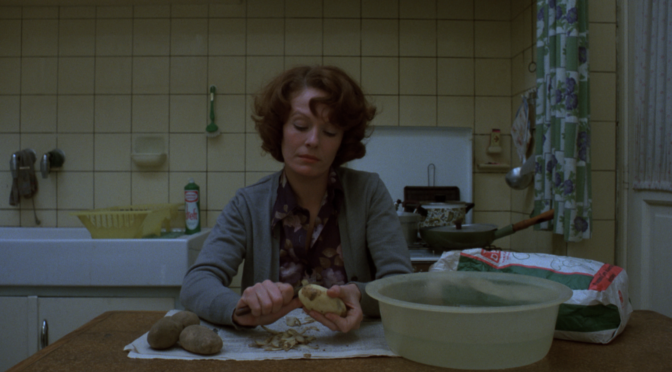 Chantal Akerman’s three-and-a-half-hour masterpiece of suffocating domesticity, is a work of existential feminism which owes much to the thinking of Simone de Beauvoir and Betty Freidan. JEANNE DIELMAN, 23 COMMERCE QUAY, 1080 BRUSSELS (1975) is about Jeanne Dielman, a widow who spends her days caring for her house and her teenage son with minute precision. She is confined day and night to the same rooms, only leaving to go shopping or drink a solitary cup of coffee in a lonely café. In order to keep house and home, she admits weekly male appointments to her rooms and, while the potatoes come to the boil, she has sex with them for money.
Chantal Akerman’s three-and-a-half-hour masterpiece of suffocating domesticity, is a work of existential feminism which owes much to the thinking of Simone de Beauvoir and Betty Freidan. JEANNE DIELMAN, 23 COMMERCE QUAY, 1080 BRUSSELS (1975) is about Jeanne Dielman, a widow who spends her days caring for her house and her teenage son with minute precision. She is confined day and night to the same rooms, only leaving to go shopping or drink a solitary cup of coffee in a lonely café. In order to keep house and home, she admits weekly male appointments to her rooms and, while the potatoes come to the boil, she has sex with them for money.
The genius of Akerman’s magnum opus is its lengthy running time: without which the audience could not appreciate the slow descent which Dielman undergoes. It conveys the unstimulating emptiness of her life. One watches as she makes coffee, switches on a light, opens a window, switches off a light, folds pyjamas, washes the dishes, peels potatoes…each task is done with careful precision as if she has completed it a hundred times before.
Delphine Seyrig, who stars as Dielman, gives a perfectly passive performance, her almost expressionless face appears as a mask which suppresses a multitude of emotions. The action of the film is slow and drawn-out, emulating the shear amount of time which the character has to dwell upon her life. Even when her son comes home there is little rest-bite from the oppressive silence. And when things begin to get out of sync for Dielman, she cannot fill her time at all; being forced to sit motionless in a chair or becoming flustered and frantic with the tasks that were so routine.
“Delphine Seyrig, who stars as Dielman, gives a perfectly passive performance, her almost expressionless face appears as a mask which suppresses a multitude of emotions.”
The horror of the film lies in the slow realisation that the character has no agency, and seemingly no way out of her current state. She cannot escape. There is no alternative for a middle-class woman such as herself, who has always been told she can find fulfilment in a domestic lifestyle. She has accepted that this is her fate as a woman and perhaps blames herself for not being satisfied; she has a home, and a child to care for, she knits and listens to the radio – after all, what more could she ask for?
The time given to this film also allows the audience to become aligned with the protagonist, existing at a similar pace to her. The cinematography comprises very simple static shots which are held for long periods and repeated often. This gives the sense that the viewer is sitting in the same room as Dielman, or standing on the same street, watching her go about her daily tasks. Ordinary sounds are magnified – probably due to the quality of the recording technology at the time, rather than by design; yet still it adds atmosphere – and no extra-diegetic sound is used at all.
Finally, after it seems like it will never end, the pressure gets too much for Dielman and the film comes to a dramatic climax. The final frame is held for a long time. Long enough for the audience to get over their shock and begin to reflect on this exhausting experience.

